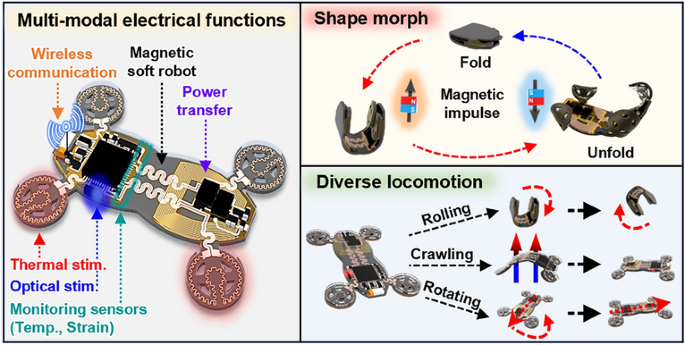2025-04-07 ペンシルベニア州立大学 (Penn State)
<関連情報>
- https://www.psu.edu/news/materials-research-institute/story/tiny-soft-robot-flexes-its-potential-life-saver
- https://link.springer.com/article/10.1007/s40820-024-01601-3#Ack1
ワイヤレス多機能システム統合型プログラマブルソフトロボット Wireless, Multifunctional System-Integrated Programmable Soft Robot
Sungkeun Han,Jeong-Woong Shin,Joong Hoon Lee,Bowen Li,Gwan-Jin Ko,Tae-Min Jang,Ankan Dutta,Won Bae Han,Seung Min Yang,Dong-Je Kim,Heeseok Kang,Jun Hyeon Lim,Chan-Hwi Eom,So Jeong Choi,Huanyu Cheng & Suk-Won Hwang
Nano-Micro Letters Published:17 February 2025
DOI:https://doi.org/10.1007/s40820-024-01601-3

Highlights
- A soft, untethered electronic robot that integrates magnetically responsive engineered composites, enabling reversible programming and a diverse range of motions and shapes.
- Seamless integration of a meticulously designed soft/flexible electronic system with the magnetic soft robot guarantees the stable and accurate execution of multi-modal electrical functions while preserving the integrity of its mechanical movement.
- The comprehensive demonstration illustrates the feasibility of the untethered, integrated magnetic soft robot, highlighting its stable operation, adaptability, and ability to perform complex tasks under diverse conditions.
Abstract
Soft robots have partially or entirely provided versatile opportunities for issues or roles that cannot be addressed by conventional machine robots, although most studies are limited to designs, controls, or physical/mechanical motions. Here, we present a transformable, reconfigurable robotic platform created by the integration of magnetically responsive soft composite matrices with deformable multifunctional electronics. Magnetic compounds engineered to undergo phase transition at a low temperature can readily achieve reversible magnetization and conduct various changes of motions and shapes. Thin and flexible electronic system designed with mechanical dynamics does not interfere with movements of the soft electronic robot, and the performances of wireless circuit, sensors, and devices are independent of a variety of activities, all of which are verified by theoretical studies. Demonstration of navigations and electronic operations in an artificial track highlights the potential of the integrated soft robot for on-demand, environments-responsive movements/metamorphoses, and optoelectrical detection and stimulation. Further improvements to a miniaturized, sophisticated system with material options enable in situ monitoring and treatment in envisioned areas such as biomedical implants.



